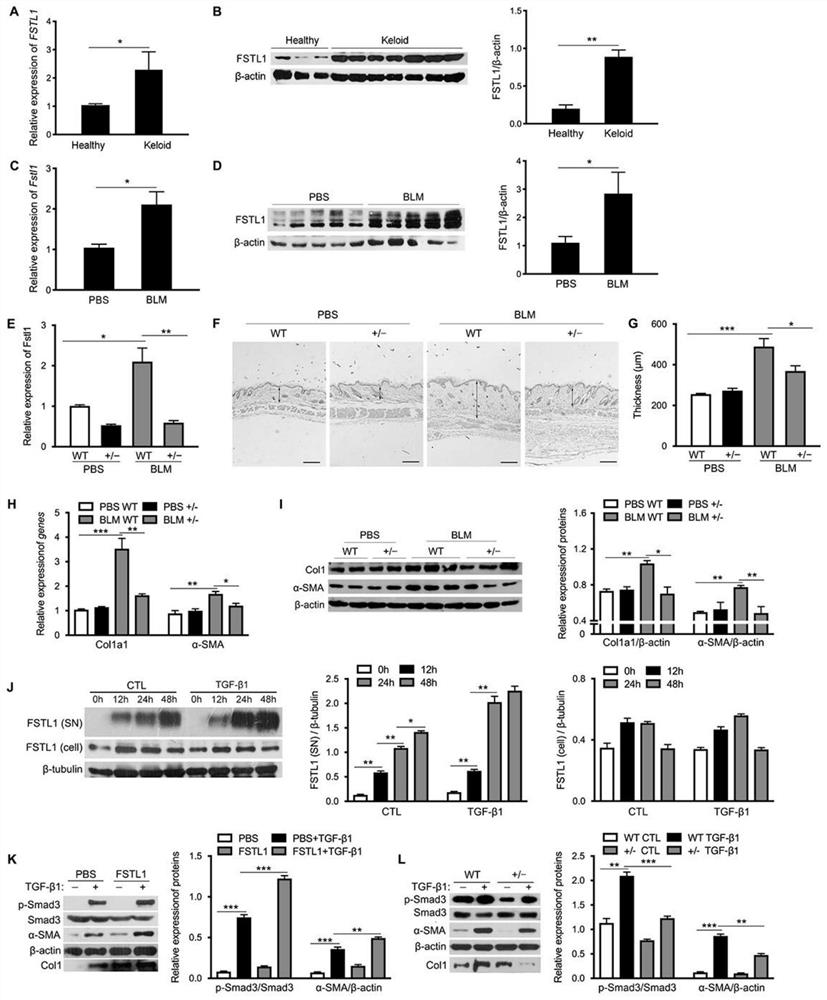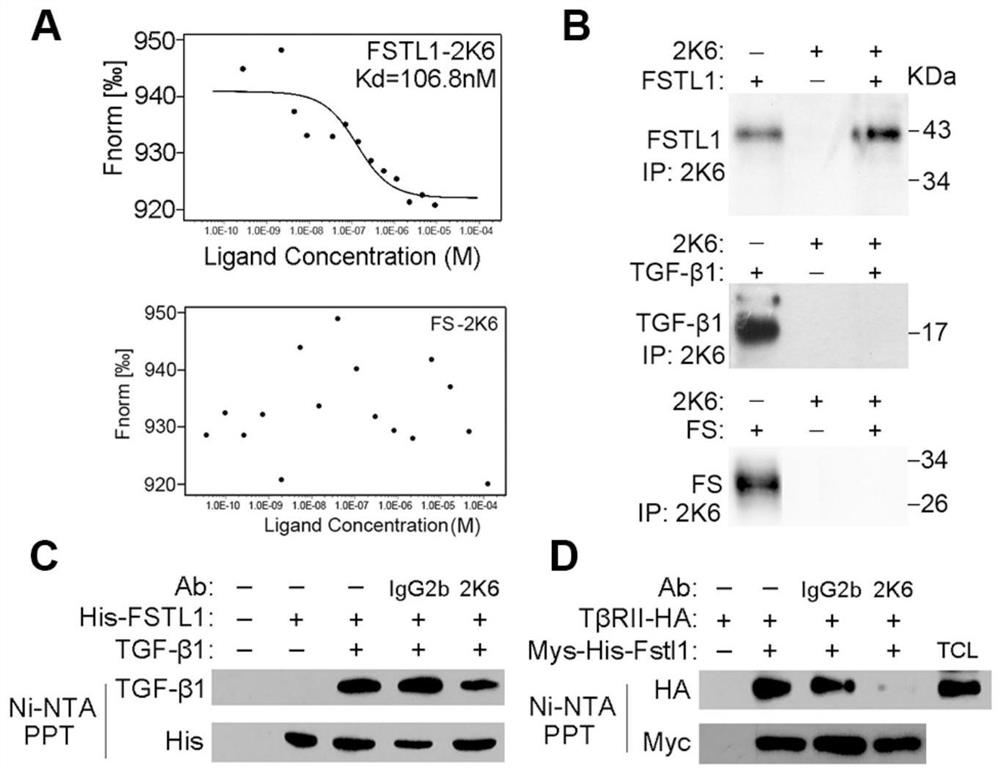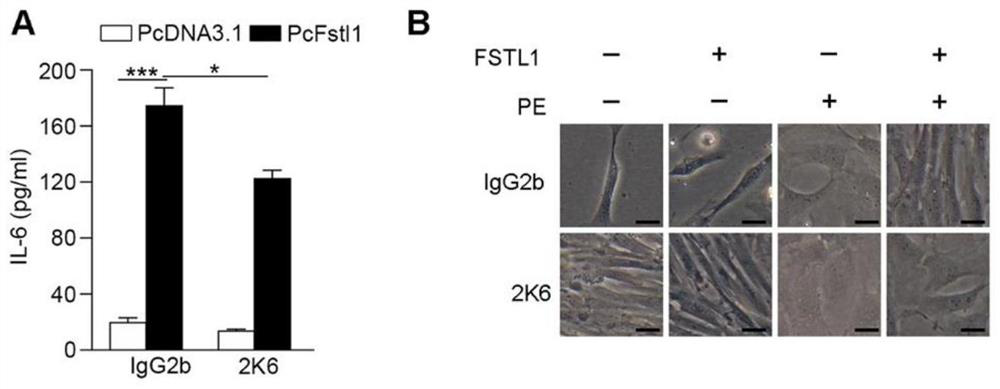Neutralizing antibody of follistatin-like 1 and application thereof
An antibody and neutralization technology, applied in the direction of antibodies, immunoglobulins, anti-animal/human immunoglobulins, etc., can solve the problem that the role of FSTL1 has not been elucidated
- Summary
- Abstract
- Description
- Claims
- Application Information
AI Technical Summary
Problems solved by technology
Method used
Image
Examples
Embodiment 1
[0053] Example 1. FSTL1 has a key facilitative role in skin fibrosis disease progression.
[0054] Skin fibrosis mainly occurs in the dermis, manifested by the proliferation of support cells such as fibroblasts and the expression of a large number of extracellular matrix proteins, accompanied by the infiltration of inflammatory factors and the production of a large number of cytokines. Current studies have shown that TGF-β1 is a key factor regulating the activation and proliferation of fibroblasts in the process of skin fibrosis. The research results released by our laboratory have confirmed that FSTL1 can promote the activation of myofibroblasts and the expression of extracellular matrix by promoting the TGF-β1 signaling pathway in the pathogenesis of pulmonary fibrosis. We speculate that FSTL1 is involved in the process of skin fibrosis, regulates the proliferation and activation of fibroblasts, the synthesis and deposition of extracellular matrix, and used experiments to st...
Embodiment 2
[0060] Example 2. Murine FSTL1 monoclonal antibody 2K6 can specifically bind to FSTL1 protein, and can antagonize the binding of FSTL1 to TGF-β1 or TGF-β1 receptor.
[0061] In order to confirm that the 2K6 monoclonal antibody is a neutralizing antibody to FSTL1, we first tested whether the 2K6 antibody can specifically bind to the FSTL1 protein. figure 2 The results of A microcalorimetric heat surge experiment showed that 2K6 monoclonal antibody can bind to FSTL1 protein, and the binding constant (Kd) is 106.8nM, but cannot bind to FSTL1 family protein FS; figure 2 As shown in the results of immunoprecipitation experiments in B, 2K6 monoclonal antibody can bind to FSTL1 protein, but cannot bind to TGF-β1 or FS, which shows that the binding of 2K6 monoclonal antibody to FSTL1 is very specific. Studies have proved that FSTL1 exerts its biological function mainly by promoting the activity of TGF-β1 signaling pathway. The specific mechanism is that FSTL1 can simultaneously bind...
Embodiment 3
[0064] Example 3. Murine FSTL1 monoclonal antibody 2K6 can neutralize the biological function of FSTL1.
[0065] After confirming the specificity of 2K6 mAb by co-immunoprecipitation experiments, we tested the biological activity of FSTL1 mAb 2K6 using two in vitro cell models. In previous reports on rheumatoid arthritis, it was found that Fstl1 can promote the expression of IL-6 inflammatory cytokines in Cos7 cells, so we constructed a cell model in which Fstl1 plasmid was transfected in Cos7 cells, and detected the expression of Cos7 after overexpressing Fstl1 by ELISA experiments. The expression level of the inflammatory factor IL-6 secreted by the cells. After transfecting pc-Fstl1 plasmid and control pc-DNA3.1 plasmid in Cos7 cells for 24 hours, exogenously added 2K6 monoclonal antibody and control antibody IgG2b for 48 hours, it was found that Fstl1 promoted the inflammatory response under the action of monoclonal antibody The effect was significantly reversed ( image...
PUM
 Login to View More
Login to View More Abstract
Description
Claims
Application Information
 Login to View More
Login to View More - R&D
- Intellectual Property
- Life Sciences
- Materials
- Tech Scout
- Unparalleled Data Quality
- Higher Quality Content
- 60% Fewer Hallucinations
Browse by: Latest US Patents, China's latest patents, Technical Efficacy Thesaurus, Application Domain, Technology Topic, Popular Technical Reports.
© 2025 PatSnap. All rights reserved.Legal|Privacy policy|Modern Slavery Act Transparency Statement|Sitemap|About US| Contact US: help@patsnap.com



